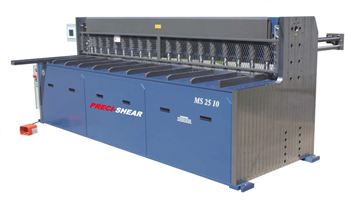Preventing Shearing Problems
September 12, 2014
Every fabricator knows that distortion in the end product is his enemy. The best way to avoid the problem is setting on the blade properly and matching the job elements with the requirements of the blade on your shearing equipment.
Match the material and blade
Each time a fabricator works on a sharing job, he needs to check these factors that affect the blade:
- the condition of the cutting blade
- the tonnage of the machine
- the size of the area between the upper blade and lower blade
- the angle required for the blade
- how it is gripped to keep it steady
Each job needs to be evaluated for these variables:
- grade of material needed to satisfactorily complete the job
- thickness of the material
- type and shape of the cut
How distortion happens
If a fabricator running the shear uses a 5/8” thick plate for a job, the correct procedure is to tighten the manual hold-down and follow through with the shear. If he then proceeds to use a 1/2”-thick workpiece but forgets to adjust the manual hold-down, the result is distortion. This happens because the plate will automatically flip up to a very small extent. The long-term result is a blade that is worn before its time. If done often, this can actually damage the frame of the equipment.
Many hydraulic cutters, like those made by Preci-Shear, use hydraulic hold-down clamps which prevent the problem. Since the operator doesn’t have to worry about making manual adjustments, he can change the thickness of the material without concern.
Another factor that needs to be considered is the tonnage recommended by the shearing manufacturer. The tonnage is a factor of the equipment’s design and the type of hydraulics it uses.
The importance of the blade
There are two basic types of blade approach:
The first, called a low-rake-angle, works like a guillotine. This type of hydraulic guillotine shearing machine makes a very clean cut on thin material, without concern for distortion. The equipment for this approach needs to have a good deal of tonnage.
The second type, called high-rake-angle shear approach, works like a scissors. Since the pressure along the cut is at one point at a time, not the entire length, the power of the cutting action is strong. But if the rake angle is set wrong, distortion is the result since it pulls the metal while the blade slices it.
With each of the two types of blade approaches, distortion can happen. To prevent it, different types of blades are made. For example, manufacturers make blades that curve down in the middle. This means that they don’t make a standard scissor cut, moving from left to right. Instead the cut starts in the center and moves outward left and right at the same time.
Research the different types of blades on the market. Matching the blade to the job leverages the equipment’s power more efficiently and also reduces the chance of distortion. Figure out which type of equipment works best on each job, a guillotine shear or a scissors type of machine.

